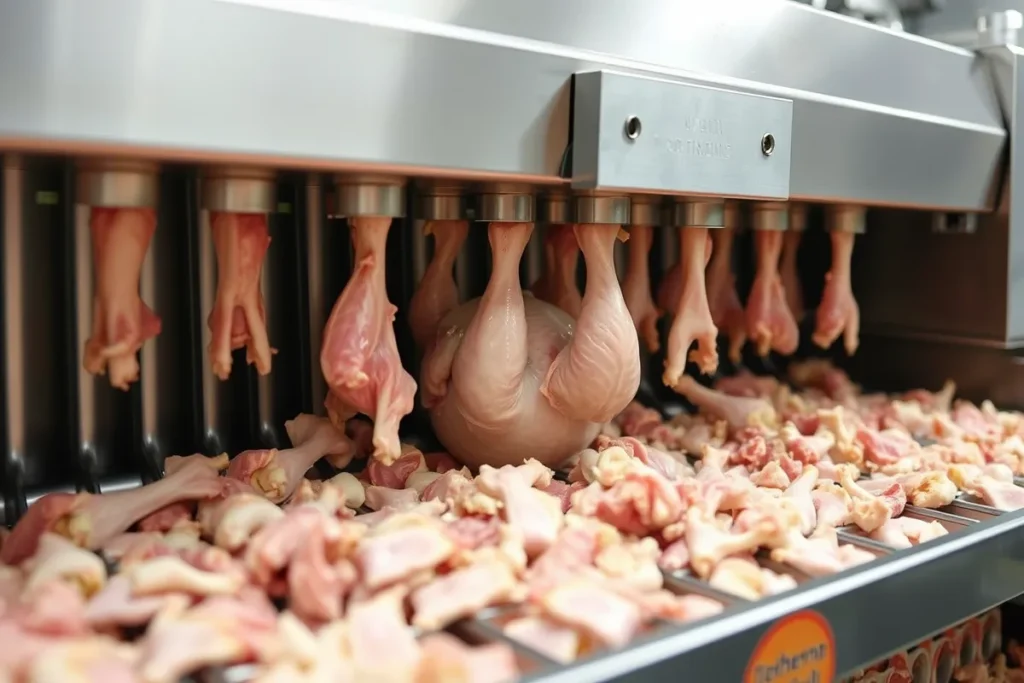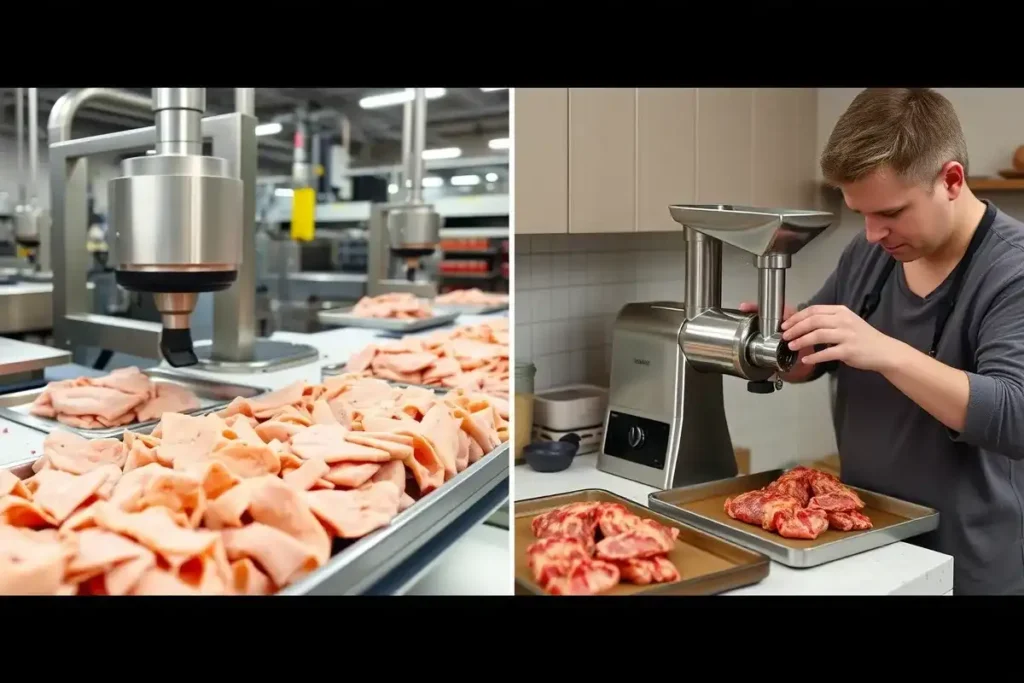Chicken breast deli meat is a favorite in many homes. It’s lean and can be used in many dishes. But, have you ever thought about how it’s made? This guide will take you through the whole process, from picking the best ingredients to how it’s stored.
Making chicken breast deli meat is a detailed process. It ensures the meat is of high quality, tastes great, and is safe to eat. By learning about deli meat production, you’ll see the effort put into every slice. Let’s explore how this meat goes from farm to your table, showing you the science and rules behind it.
Understanding Deli Chicken Breast: From Farm to Slice
Making high-quality deli chicken breast is a detailed process. It starts with picking the best cuts for your sandwich. We’ll look into the chicken types used and the strict quality rules in this industry.

Types of Chicken Used in Deli Meat Production
Deli chicken breast comes from specific chicken breeds. These breeds are chosen for their great taste and soft texture. Chicken breast processing often mixes:
- Broiler chickens: Fast-growing, with lots of breast meat.
- Roaster chickens: Bigger, with juicier and more developed breasts.
- Free-range chickens: Roam freely, giving a unique taste and texture.
Choosing these chicken types ensures the deli meat production meets high standards. This makes sure the product is top-notch for those who are picky.
Quality Standards and Selection Process
Keeping the quality of chicken breast processing high is key in the deli world. High quality standards check the chicken’s look, color, and condition. Only the cleanest cuts are turned into the tasty deli chicken breast you love.
| Quality Metric | Ideal Specification |
|---|---|
| Meat Color | Pale pink to white |
| Texture | Firm and plump |
| Fat Content | Minimal visible fat |
| Appearance | Smooth, unblemished skin |
Following these strict quality standards makes sure only the best chicken breasts reach you. They go from the farm to your plate, making every bite a delight.
Raw Material Preparation and Initial Processing Steps
The journey of making tasty chicken breast deli meat starts with preparing the raw materials. First, whole chickens are sourced. Then, the chicken breasts are deboned, trimmed, and cut into pieces for further processing.
The first step in chicken breast processing is deboning. Skilled workers carefully remove the chicken breasts from the carcass. They make sure the meat is clean and not damaged.
After deboning, the trimming process begins. Excess fat and connective tissue are removed. This leaves a clean, uniform chicken breast. It ensures the final deli meat looks and feels the same.
The chicken breasts are then cut into smaller, uniform pieces. These pieces are usually 2 to 4 inches in size. This makes handling and transporting the raw material easier during deli meat production.
These initial steps are the base of the how do they make deli meat journey. By carefully preparing the raw materials, manufacturers get the chicken breasts ready for the next stages. There, they will be turned into the tasty deli meat we love.
| Initial Processing Step | Description |
|---|---|
| Deboning | Removal of chicken breasts from the carcass |
| Trimming | Removal of excess fat and connective tissue |
| Cutting | Dividing the chicken breasts into smaller, uniform pieces |
The Science Behind Chicken Breast Processing Methods
Creating top-notch chicken breast deli meat needs a solid grasp of the science behind it. From the detailed mechanical separation to the careful temperature control and curing and brining steps, each part is key. They ensure the meat is safe to eat and tastes great.

Mechanical Separation Techniques
The first step in making chicken breast deli meat is mechanical separation. This is where the meat is gently taken off the bones and skin. Advanced tools and machines help get the job done right, keeping the chicken breast quality high.
Temperature Control and Food Safety Measures
Keeping the temperature just right is crucial for food safety. By controlling the temperature and following strict cleaning rules, the risk of harmful bacteria is greatly reduced. This makes sure the final product is safe and meets high food safety standards.
Curing and Brining Processes
The special taste and texture of chicken breast deli meat come from curing and brining. These steps add salt, nitrites, and other ingredients. They not only boost the flavor but also help cure and brine the meat. This keeps it fresh longer and preserves its quality.
| Mechanical Separation Techniques | Temperature Control and Food Safety | Curing and Brining Processes |
|---|---|---|
| – Bone and skin removal – Consistent yield – Tissue integrity | – Strict temperature management – Sanitation protocols – Minimizing bacterial growth | – Salt and nitrite addition – Flavor enhancement – Shelf life extension |
How is Chicken Breast Deli Meat Made?
The making of chicken breast deli meat is a detailed process. It turns fresh, top-quality chicken into tender, tasty slices for our sandwiches. Let’s explore the steps from the farm to our plates.
First, the deli meat production process starts with picking the best chicken breasts. Experts check and grade the chicken for quality and safety. Then, they clean and trim it to remove any bad parts or extra fat.
Next, the chicken breasts go through mechanical separation. This means cutting, slicing, and shredding to get the right texture. Keeping the chicken at the right temperature is key to keep it fresh and safe.
| Key Steps in Chicken Breast Deli Meat Production |
|---|
| 1. Selection and Inspection of Chicken Breasts |
| 2. Cleaning and Trimming of Raw Materials |
| 3. Mechanical Separation and Cutting |
| 4. Curing and Brining Processes |
| 5. Packaging and Storage |
The curing and brining steps are important for flavor and preservation. They add spices, seasonings, and curing agents. These enhance the taste and keep the meat fresh longer.
Finally, the chicken is packaged to keep it fresh and safe. It’s stored in cool places with controlled air to prevent spoilage. This way, it stays good until we buy it.
Essential Ingredients and Additives in Deli Chicken
Deli chicken is made with a mix of ingredients that boost its flavor, texture, and shelf life. These include common preservatives and the debate over natural versus artificial components. Let’s explore what makes deli chicken a tasty and versatile choice.
Common Preservatives Used
Preservatives are key in making deli meat last longer and stay fresh. Here are some common ones found in deli chicken meat:
- Sodium nitrite: This helps stop harmful bacteria like Clostridium botulinum and gives cured meats their pink color.
- Sodium erythorbate: It works with sodium nitrite to speed up curing and prevent nitrosamines, which could be harmful.
- Sodium benzoate: This keeps mold and yeast from growing, making deli chicken meat last longer.
Natural vs. Artificial Ingredients
More people want to know what’s in their food, leading to a debate on natural versus artificial additives in deli meat ingredients. Some makers choose natural options like celery powder. Others use synthetic preservatives because they’re cheaper and work well.
Whether to use natural or artificial ingredients in deli chicken meat depends on what you prefer. Both methods can make safe and tasty food when done right.
Commercial Production Equipment and Technology
In today’s deli meat industry, special equipment and new technology are key. They help make top-notch chicken breast deli meat. From advanced slicing machines to new packaging systems, the industry has changed a lot.
The high-speed slicing machine is a big part of deli meat production. It slices chicken breast meat with great precision and consistency. This ensures the slices are the same thickness and look good. Also, chicken processing technology like automated deboning and trimming systems make the production faster. This saves money and makes things more efficient.
- High-speed slicing machines for consistent, uniform slices
- Automated deboning and trimming systems to enhance efficiency
- Advanced packaging equipment to preserve freshness and extend shelf life
- Sophisticated temperature control systems to maintain food safety standards
Modern packaging equipment is also very important. It keeps the deli meat fresh and extends its shelf life. Automated packaging systems, including gas-flushing technology and hermetic sealing, help keep the meat fresh.
At the heart of these improvements are advanced temperature control systems. These systems keep the meat at the perfect temperature during production. This ensures the meat is safe and of high quality.
The mix of new equipment and technology has changed how chicken breast deli meat is made. It lets manufacturers make high-quality, tasty, and safe products for everyone.
Quality Control Measures in Deli Meat Manufacturing
Keeping deli meat safe and of high quality is crucial in the food world. Manufacturers follow strict rules to protect consumers and meet USDA standards. They use a variety of methods, including safety checks, tests, and strict following of rules.
Safety Protocols and Testing
Deli meat makers have strong safety steps to prevent illness. These steps include:
- Keeping everything clean and hygienic during making
- Testing raw materials, products in progress, and finished goods for harmful germs
- Using tools like metal detectors and x-ray scanners to find and remove harmful objects
- Keeping production equipment in top shape for best results
USDA Regulations and Compliance
Deli meat makers must follow USDA rules closely. These rules cover everything from getting raw materials to packaging and sending out products. They must:
- Follow USDA’s strict labeling and nutrition rules
- Keep detailed records to show they follow safety standards
- Pass regular USDA checks to prove their operations are sound
- Act quickly to fix any problems found
By sticking to these strict quality and rule-following steps, deli meat makers can offer safe and top-quality food. This builds trust and confidence in the industry.
Packaging and Storage Methods for Deli Chicken
Keeping deli chicken fresh and of high quality is key for a great dining experience. Many factors, like packaging and storage, play a big role. They help keep the deli meat packaging, shelf life, and storage methods top-notch.
Vacuum-sealed plastic is a common choice for packaging deli chicken. This tight seal keeps air out, which helps the meat stay fresh longer. Another option is modified atmosphere packaging (MAP). It uses a special mix of gases to keep the chicken fresh even longer.
| Packaging Material | Shelf Life | Advantages |
|---|---|---|
| Vacuum-sealed Plastic | 7-10 days | Airtight seal, prevents contamination |
| Modified Atmosphere Packaging (MAP) | 10-14 days | Controlled gas blend, extended shelf life |
Storing deli chicken right is also very important. Keeping it at a cool temperature, between 40°F and 140°F, stops bad bacteria from growing. Also, making sure to use the oldest items first helps keep the chicken fresh longer.
- Store deli chicken at the recommended temperature of 40°F to 140°F
- Rotate stock regularly to ensure first-in, first-out (FIFO) inventory management
- Consider using vacuum-sealed or modified atmosphere packaging to extend shelf life
By using these deli meat packaging and storage methods, deli places can make sure their chicken is always fresh and of the best quality.
Creating Homemade Chicken Deli Meat
Want to make your own homemade chicken deli meat without preservatives? You can do it at home with just a few tools and a simple recipe. Enjoy tasty and healthy chicken lunch meat recipes that are better than store-bought.

Kitchen Equipment Needed
- Meat grinder or food processor
- Mixing bowls
- Baking sheet or loaf pan
- Parchment paper
- Slicing knife
Step-by-Step Recipe Guide
- Begin with top-quality, boneless, skinless chicken breasts. Remove any extra fat and cut the meat into 1-inch cubes.
- Grind the chicken in a meat grinder or food processor until it’s finely ground.
- In a big mixing bowl, mix the ground chicken with your favorite seasonings. Use salt, pepper, garlic powder, and any herbs or spices you like.
- Press the seasoned chicken mix into a baking sheet or loaf pan covered with parchment paper. Make sure it’s spread out evenly.
- Bake the chicken deli meat in a preheated oven at 325°F (165°C) for 45-60 minutes. It should reach an internal temperature of 165°F (74°C).
- Let the chicken lunch meat cool down completely. Then, slice it to your liking with a sharp knife.
- Keep the sliced homemade chicken deli meat in an airtight container in the fridge for up to 1 week. Or freeze it for longer storage.
This simple recipe lets you make your own homemade chicken deli meat. You get to choose the ingredients, making it a healthier and tastier choice than store-bought.
Health Considerations and Nutritional Profile
When we talk about deli chicken nutrition, we must think about health risks. Chicken breast is lean and full of protein, but deli meat processing can add unhealthy elements. Let’s dive into the details of deli chicken’s nutritional profile and health concerns.
You May Also Like:
- Ramen Recipe with Broccolini: The Ultimate Comfort Food Guide!
- Benihana Chicken Fried Rice: Easy Recipe at Home
- Spinach with Boiled Eggs Recipe: Easy Steps for a Flavorful Dish
Processed deli chicken often has more sodium and preservatives than fresh chicken. Eating too much processed meat might raise the risk of cardiovascular disease and certain cancers. But, it’s key to remember that research on processed meat is still going on. The risks can change based on your diet and lifestyle.
| Nutrient | Deli Chicken Breast | Roasted Chicken Breast |
|---|---|---|
| Calories | 90 kcal (per 2 oz serving) | 165 kcal (per 3.5 oz serving) |
| Protein | 18 g (per 2 oz serving) | 31 g (per 3.5 oz serving) |
| Sodium | 600 mg (per 2 oz serving) | 70 mg (per 3.5 oz serving) |
| Saturated Fat | 1 g (per 2 oz serving) | 1 g (per 3.5 oz serving) |
The table shows the nutritional differences between deli chicken breast and roasted chicken breast. While deli chicken is easy and popular, it has more sodium. This is something to think about when eating processed meat regularly.
To eat healthily, limit deli chicken and add fresh, unprocessed chicken to your meals. Knowing about deli chicken nutrition and health risks helps you make better choices. This way, you can meet your health goals.
Conclusion
In this guide, we’ve looked at how chicken breast deli meat is made. We started with choosing the best poultry and ended with the latest processing methods. The deli meat industry has grown a lot. This is because people want easy, tasty, and healthy food.
The making of chicken breast deli meat shows the industry’s dedication to safety and quality. Every step, from preparing the raw materials to packaging and storage, is carefully planned. This ensures the product is safe, tasty, and consistent.
As the industry grows, we’ll see more focus on clean labels and natural ingredients. There will also be more efforts to make production sustainable. The future of chicken breast deli meat looks bright. It will meet the needs of health-conscious consumers while keeping the taste and convenience we love.
Frequently Asked Questions (FAQs)
Is chicken breast deli meat processed?
Yes, chicken breast deli meat is processed. It goes through steps like deboning, trimming, curing, and packaging. This makes the final deli product. For more details, read the full article here.
How do they make sliced chicken breast?
To make sliced chicken breast, they first debone and trim whole chicken breasts. Then, they cure, season, and sometimes smoke them. Finally, they slice the meat into thin, uniform pieces. For more details, read the full article here.
How is Boar’s Head chicken made?
Boar’s Head chicken is made from high-quality chicken breasts. They cure, smoke, and slice the breasts. They also add special seasonings and additives to enhance flavor and texture.
How do they make deli meat?
Making deli meat involves several steps. First, they prepare the raw material by deboning and trimming. Then, they cure and season it. Next, they cook or smoke it. Finally, they slice and package it. For more details, read the full article here.
What is the process of making deli meat?
Making deli meat includes several steps. They start by selecting and preparing the raw meat. Then, they cure it with salt, nitrites, and seasonings. After that, they cook or smoke it. Next, they slice it into thin pieces. Finally, they package it for sale.
How do they make homemade chicken deli meat?
To make homemade chicken deli meat, start with boneless, skinless chicken breasts. Brine the chicken in saltwater to add flavor and moisture. Season it with your favorite spices and herbs. Roast or smoke the chicken until it’s cooked through. Slice it into thin pieces. Store it in the fridge or freezer for later use.

